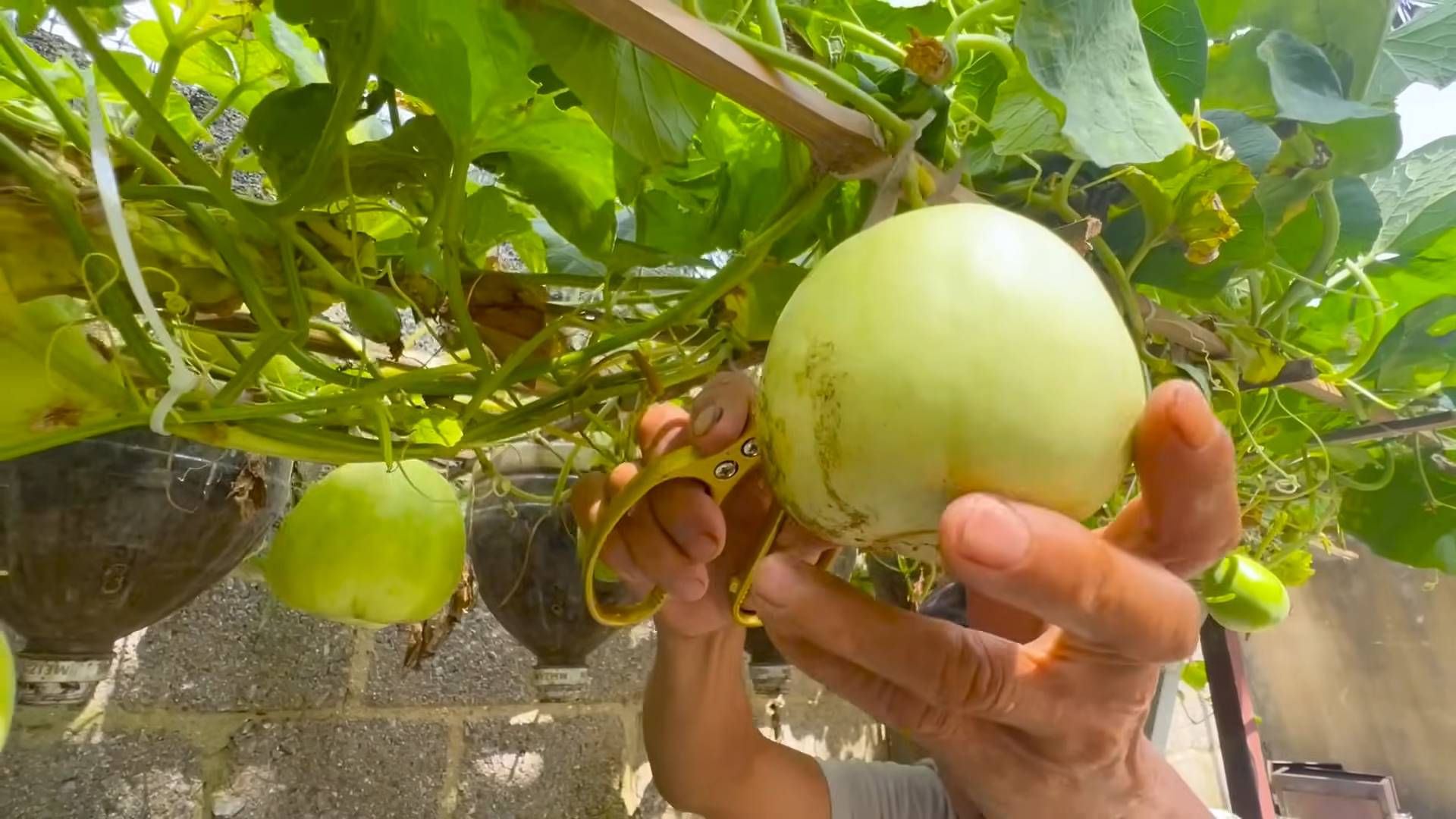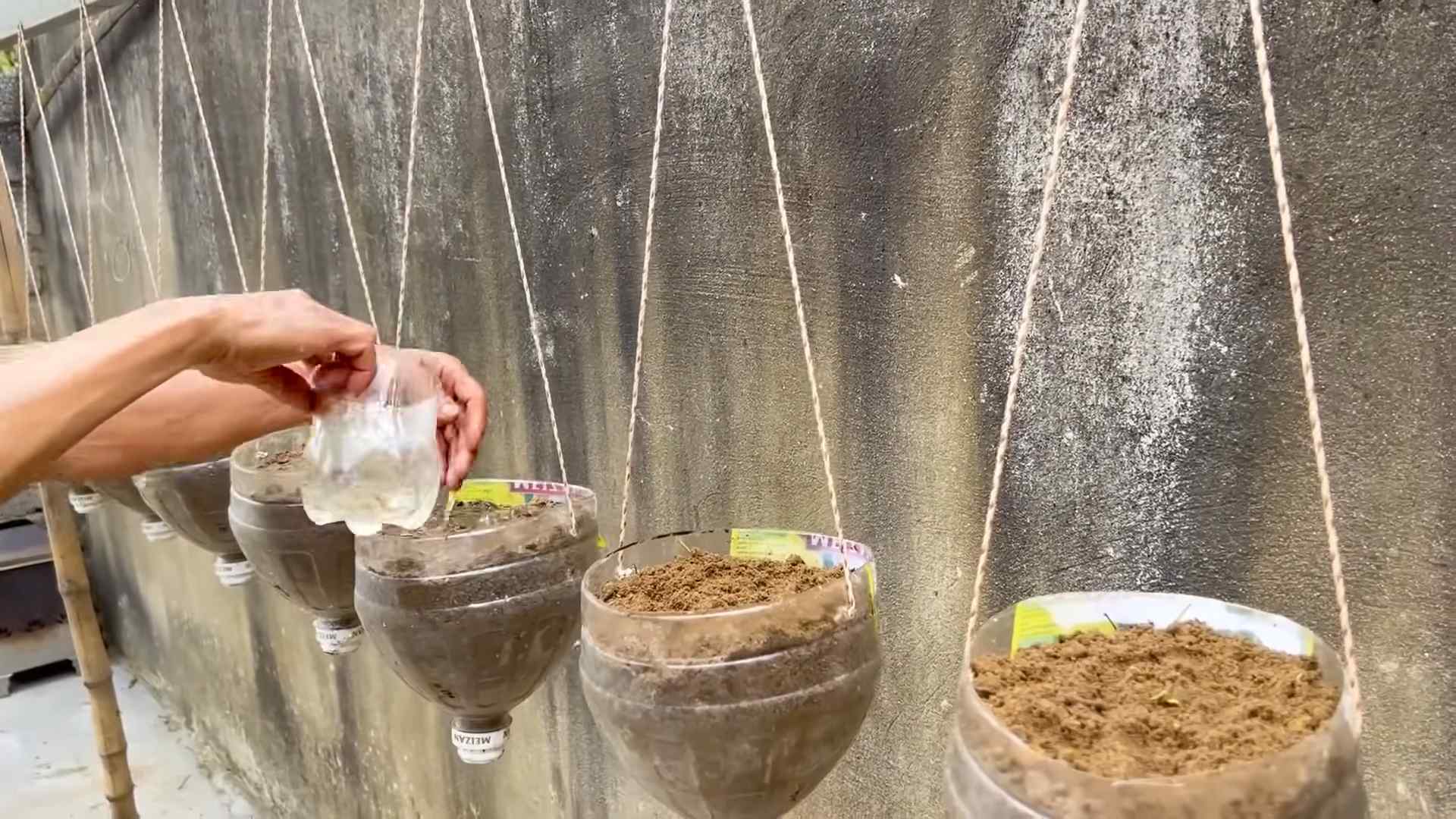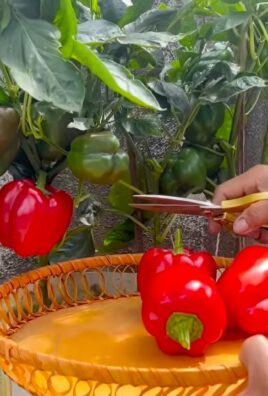Growing Melons Secret Hack: Unlock the juicy sweetness you’ve always dreamed of! Have you ever bitten into a store-bought melon and thought, “I could do better”? I know I have! There’s nothing quite like the satisfaction of harvesting your own sun-ripened, perfectly sweet melon straight from your backyard. But let’s be honest, growing melons can sometimes feel like a gamble. That’s where this secret hack comes in – it’s a game-changer!
Melons have a rich history, cultivated for centuries across various cultures. From ancient Egypt, where they were found in tombs, to the vibrant markets of Asia, melons have always been prized for their refreshing taste and nutritional value. But even with centuries of cultivation, achieving that perfect melon flavor and size can be tricky.
That’s why I’m so excited to share this growing melons secret hack with you. It addresses a common problem: inconsistent watering and nutrient delivery. Many gardeners struggle with knowing exactly when and how much to water their melon plants, leading to bland, small, or even cracked fruits. This simple DIY trick will help you provide your melon plants with the consistent moisture and nutrients they crave, resulting in a bountiful harvest of the sweetest, most delicious melons you’ve ever tasted. Get ready to impress your friends and family with your melon-growing prowess!

Unlock the Secrets to Growing Juicy, Delicious Melons: My Foolproof DIY Hack!
Okay, melon lovers, gather ’round! I’m about to share my absolute favorite DIY hack for growing the sweetest, most flavorful melons you’ve ever tasted. Forget those bland, watery grocery store melons – we’re talking homegrown perfection! This method focuses on maximizing sunlight, warmth, and drainage, which are the holy trinity of melon growing. Get ready to impress your friends and family with your melon-growing prowess!
Understanding the Melon’s Needs: A Quick Primer
Before we dive into the hack, let’s quickly cover what melons crave. They’re sun-worshippers, needing at least 6-8 hours of direct sunlight daily. They also adore warmth, both in the air and the soil. And finally, excellent drainage is crucial – soggy roots are a melon’s worst enemy. This hack addresses all three of these needs beautifully.
The DIY Hack: Black Plastic Mulch and Raised Rows
This hack combines the power of black plastic mulch with raised rows to create the ideal melon-growing environment. The black plastic warms the soil, suppresses weeds, and reflects sunlight back onto the plants. The raised rows improve drainage and further warm the soil. It’s a win-win!
Materials You’ll Need:
* Black plastic mulch (heavy-duty is best)
* Gardening gloves
* Measuring tape or ruler
* Shovel or garden fork
* Rake
* Melon seedlings (your favorite variety!)
* Watering can or hose
* Fertilizer specifically formulated for melons (optional, but recommended)
* Landscape staples or rocks to secure the plastic mulch
* Scissors or utility knife
Step-by-Step Instructions:
Phase 1: Preparing the Garden Bed
1. Choose the Right Location: Select a spot in your garden that receives at least 6-8 hours of direct sunlight each day. Make sure it’s also relatively sheltered from strong winds. Melons don’t like being tossed around!
2. Clear the Area: Remove any existing vegetation, rocks, or debris from the area you’ve chosen. You want a clean slate to work with.
3. Amend the Soil (If Necessary): Melons thrive in well-draining, fertile soil. If your soil is heavy clay or sandy, amend it with compost or well-rotted manure. This will improve drainage and add essential nutrients. I usually dig in a generous amount of compost – about 2-3 inches – and mix it thoroughly with the existing soil.
4. Create Raised Rows: This is where the magic begins! Use your shovel or garden fork to create raised rows that are about 6-8 inches high and 2-3 feet wide. The length of the rows will depend on how many melon plants you’re growing. Space the rows about 3-4 feet apart to allow for ample room for the vines to spread. I like to use a rake to smooth out the tops of the rows and make them nice and even.
Phase 2: Laying the Black Plastic Mulch
5. Measure and Cut the Plastic: Measure the length of your raised rows and add a few extra feet on each end for securing the plastic. Cut the black plastic mulch to the appropriate length using scissors or a utility knife.
6. Lay the Plastic: Carefully lay the black plastic mulch over the raised rows, ensuring that it covers the entire row. Try to keep it as taut as possible to prevent it from flapping in the wind.
7. Secure the Plastic: Use landscape staples or rocks to secure the edges of the plastic mulch to the ground. Place the staples or rocks every few feet to prevent the plastic from blowing away. This is a crucial step, especially if you live in a windy area!
8. Create Planting Holes: Now, it’s time to create planting holes for your melon seedlings. Use your scissors or utility knife to cut holes in the plastic mulch, spacing them about 2-3 feet apart along the rows. The size of the holes should be large enough to accommodate the root balls of your seedlings.
Phase 3: Planting the Melon Seedlings
9. Prepare the Planting Holes: Before planting, water the planting holes thoroughly. This will help to settle the soil and provide moisture for the seedlings.
10. Gently Remove Seedlings: Carefully remove the melon seedlings from their containers, being gentle with the roots. If the roots are tightly bound, gently loosen them with your fingers.
11. Plant the Seedlings: Place each seedling into a planting hole, ensuring that the top of the root ball is level with the surrounding soil. Backfill the hole with soil and gently firm it around the base of the plant.
12. Water Thoroughly: After planting, water the seedlings thoroughly to help them establish their roots.
Phase 4: Ongoing Care and Maintenance
13. Water Regularly: Melons need consistent moisture, especially during hot, dry weather. Water deeply and regularly, aiming to keep the soil consistently moist but not waterlogged. I usually water in the morning to allow the foliage to dry before nightfall, which helps to prevent fungal diseases.
14. Fertilize (Optional): If you want to give your melons an extra boost, fertilize them with a fertilizer specifically formulated for melons. Follow the instructions on the fertilizer package carefully. I usually fertilize every 2-3 weeks during the growing season.
15. Weed Control: While the black plastic mulch will suppress most weeds, you may still need to do some hand-weeding around the planting holes. Be careful not to damage the melon roots when weeding.
16. Pest and Disease Control: Keep an eye out for common melon pests and diseases, such as aphids, squash bugs, and powdery mildew. Take action promptly if you notice any problems. There are many organic and non-organic options available for pest and disease control. I prefer to use organic methods whenever possible.
17. Pollination Assistance (If Needed): Melons require pollination to produce fruit. If you’re not seeing many bees or other pollinators in your garden, you may need to hand-pollinate the flowers. This is a simple process that involves transferring pollen from the male flowers to the female flowers. You can easily find tutorials online.
18. Support the Fruit (If Needed): As the melons grow larger, they may need some support to prevent them from breaking off the vine. You can use slings made from old pantyhose or netting to support the fruit. This is especially important for larger melon varieties.
19. Harvesting: Knowing when to harvest melons can be tricky. The best way to tell if a melon is ripe is to look for these signs:
* The stem near the fruit should start to dry and crack.
* The rind should change color and become duller.
* The melon should sound hollow when you tap it.
* The melon should have a sweet aroma.
Once you’ve determined that a melon is ripe, carefully cut it from the vine with a sharp knife.
Tips for Success:
* Choose the Right Variety: Select melon varieties that are well-suited to your climate and growing conditions. Do some research to find out which varieties perform best in your area.
* Start with Healthy Seedlings: Purchase healthy, vigorous seedlings from a reputable nursery. Avoid seedlings that are leggy, yellowed, or have signs of disease.
* Don’t Overwater: While melons need consistent moisture, overwatering can lead to root rot. Make sure the soil is well-draining and avoid wateringloging the plants.
* Protect from Frost: Melons are sensitive to frost. If there’s a risk of frost, cover the plants with blankets or row covers.
* Be Patient: Melons take time to mature. Don’t get discouraged if you don’t see results right away. With proper care and attention, you’ll be rewarded with a bountiful harvest of delicious melons!
Why This Hack Works So Well:
The combination of black plastic mulch and raised rows creates a microclimate that is ideal for melon growth. The black plastic warms the soil, which promotes faster growth and earlier fruit production. It also suppresses weeds, which reduces competition for nutrients and water. The raised rows improve drainage, which prevents root rot and other fungal diseases. And the reflected sunlight from the plastic helps to ripen the melons and improve their flavor.
I’ve used this hack for years, and it has consistently produced amazing results. I’ve grown watermelons, cantaloupes, honeydew melons, and even some more exotic varieties with great success. I’m confident that you can too! So, give it a try and get ready to enjoy the sweetest, most flavorful melons you’ve ever tasted. Happy gardening!

Conclusion
So, there you have it! This simple yet incredibly effective DIY trick for growing melons is a game-changer for any gardener, regardless of experience level. We’ve unveiled the secret to unlocking a bountiful harvest of sweet, juicy melons, even in less-than-ideal conditions. Forget struggling with stunted growth, disappointing yields, or melons that just don’t quite reach their full potential. This method addresses the core needs of melon plants, providing them with the warmth, drainage, and nutrient support they crave.
Why is this a must-try? Because it’s more than just a gardening hack; it’s an investment in your gardening success. It’s about maximizing your efforts and reaping the rewards of your hard work. It’s about enjoying the unparalleled satisfaction of biting into a homegrown melon that bursts with flavor, knowing you nurtured it from seed to table. This DIY approach is also incredibly cost-effective, utilizing readily available materials and minimizing the need for expensive gardening products.
But the beauty of this technique lies in its adaptability. Feel free to experiment with variations to suit your specific needs and preferences. For example, if you live in an exceptionally hot climate, consider using lighter-colored materials for your DIY melon support to reflect some of the heat. You could also incorporate a slow-release fertilizer directly into the soil mix within the support structure for an extra boost of nutrients. Another variation is to use different types of organic matter, such as well-rotted compost or aged manure, depending on what’s readily available to you. You can even tailor the size of the support structure to accommodate different melon varieties, from smaller cantaloupes to larger watermelons.
Don’t be afraid to get creative and personalize this method to fit your unique gardening environment. The key is to understand the underlying principles – providing warmth, drainage, and support – and then adapt the technique accordingly.
We are confident that this DIY trick will revolutionize your melon-growing experience. Imagine the satisfaction of harvesting an abundance of perfectly ripe melons, knowing that you played a crucial role in their success. This isn’t just about growing melons; it’s about connecting with nature, learning new skills, and enjoying the fruits (literally!) of your labor.
So, what are you waiting for? Gather your materials, prepare your garden, and give this DIY trick a try. We’re eager to hear about your results! Share your experiences, photos, and any variations you’ve tried in the comments below. Let’s create a community of melon-growing enthusiasts and learn from each other’s successes. Remember, the best gardening knowledge is often shared knowledge. Let’s unlock the secrets to growing the best melons together! This **growing melons** secret hack is waiting to be unleashed in your garden.
Frequently Asked Questions (FAQ)
What type of melons does this DIY trick work best for?
This method is effective for a wide variety of melons, including watermelons, cantaloupes, honeydew melons, and even smaller varieties like Galia melons. The key is to adjust the size of the support structure to accommodate the specific needs of the melon variety you’re growing. Larger melons like watermelons will require a more robust and spacious support system than smaller cantaloupes. Consider the mature size of the melon when planning your DIY setup.
How often should I water the melons grown using this method?
Watering frequency depends on several factors, including your climate, soil type, and the stage of growth of the melon plants. Generally, you should aim to keep the soil consistently moist but not waterlogged. Check the soil moisture level regularly by sticking your finger a few inches into the soil. If it feels dry to the touch, it’s time to water. During hot, dry periods, you may need to water more frequently. Ensure that the drainage is adequate to prevent root rot. Drip irrigation is an excellent option for delivering water directly to the roots of the melon plants.
What type of soil is best for growing melons using this DIY trick?
Melons thrive in well-draining, fertile soil that is rich in organic matter. A sandy loam soil is ideal, as it provides good drainage and allows the roots to penetrate easily. Before planting, amend your soil with compost, aged manure, or other organic matter to improve its fertility and drainage. A slightly acidic to neutral soil pH (around 6.0 to 7.0) is also optimal for melon growth. You can test your soil pH using a soil testing kit and adjust it accordingly.
How much sunlight do melons need when grown with this method?
Melons are sun-loving plants and require at least 6-8 hours of direct sunlight per day to thrive. Choose a location in your garden that receives ample sunlight throughout the day. If you live in a particularly hot climate, some afternoon shade may be beneficial to prevent the melons from overheating. However, ensure that the plants still receive sufficient sunlight overall.
Can I use this DIY trick in a container garden?
Yes, this method can be adapted for container gardening, especially for smaller melon varieties. Choose a large container with good drainage holes. The size of the container will depend on the type of melon you’re growing. Use a high-quality potting mix that is well-draining and rich in organic matter. You may need to water more frequently when growing melons in containers, as the soil tends to dry out faster. Provide a support structure that is appropriate for the size of the container and the melon variety.
How do I know when my melons are ripe and ready to harvest?
Determining when a melon is ripe can be tricky, but there are several indicators to look for. For watermelons, check the underside of the melon where it rests on the ground. This spot should turn from white to a creamy yellow color. Also, the tendril closest to the melon should be dry and brown. For cantaloupes, the melon should slip easily from the vine with a gentle tug. The aroma should also be sweet and fragrant. Honeydew melons are ripe when the skin turns a creamy yellow color and the blossom end is slightly soft.
What are some common pests and diseases that affect melons, and how can I prevent them?
Common pests that affect melons include aphids, squash bugs, and vine borers. Diseases include powdery mildew, fusarium wilt, and anthracnose. To prevent these problems, practice good garden hygiene by removing plant debris and weeds regularly. Use insecticidal soap or neem oil to control pests. Choose disease-resistant melon varieties. Ensure good air circulation around the plants to prevent fungal diseases. Rotate your crops each year to prevent soilborne diseases from building up.
Can I start melon seeds indoors before transplanting them using this method?
Yes, starting melon seeds indoors can give you a head start on the growing season, especially in cooler climates. Sow the seeds in peat pots or biodegradable containers about 3-4 weeks before the last expected frost. Keep the soil moist and warm (around 70-80°F). Once the seedlings have developed a few true leaves and the weather has warmed up, you can transplant them into your garden using this DIY trick. Be sure to harden off the seedlings gradually before transplanting them to acclimate them to outdoor conditions.
How does this DIY trick help with drainage for melon plants?
The raised structure created by this DIY method significantly improves drainage. Melons are susceptible to root rot if their roots are constantly sitting in water. By elevating the planting area and using a well-draining soil mix, you ensure that excess water drains away quickly, preventing waterlogging and promoting healthy root growth. This is particularly important in areas with heavy clay soils or during periods of heavy rainfall.
Is it necessary to prune melon plants when using this DIY method?
Pruning melon plants can improve air circulation, reduce the risk of disease, and encourage the development of larger, higher-quality fruits. Remove any suckers (small shoots that grow from the base of the plant) to direct the plant’s energy towards fruit production. You can also prune some of the leaves to improve air circulation and sunlight penetration. However, avoid excessive pruning, as the leaves are essential for photosynthesis.




Leave a Comment